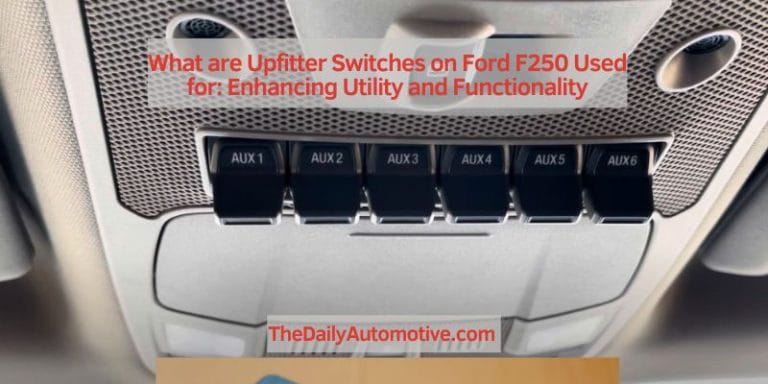How to Disengage 4 Wheel Drive Ford F150: Master the Technique
To disengage 4 wheel drive in a Ford F150, come to a complete stop, shift the transmission into neutral, and turn the dial to 2H. This will deactivate the 4WD and return the vehicle to two-wheel drive mode.
When driving off-road or in challenging road conditions, engaging the 4-wheel drive can provide added traction and stability. However, once the need for 4WD has subsided, it’s important to know how to disengage it to prevent unnecessary wear and tear on the drivetrain.
By following a few simple steps, you can easily switch your Ford F150 back to two-wheel drive mode, improving fuel efficiency and reducing stress on the vehicle’s components. This article provides a clear guide on how to disengage 4 wheel drive in a Ford F150, ensuring you can confidently transition between 4WD and 2WD as needed.
Understanding 4-wheel Drive
Functionalities Of 4-wheel Drive
4-wheel drive (4WD) systems are designed to provide power to all four wheels of a vehicle, helping it tackle rugged terrain and adverse weather conditions. This feature is especially useful for off-road driving, as well as for navigating through snow, mud, and uneven surfaces. 4WD systems can be engaged or disengaged to suit different driving conditions, offering greater control and stability.
Benefits Of Using 4-wheel Drive System
Utilizing a 4WD system offers several advantages, including:
- Enhanced traction and grip on challenging surfaces
- Improved stability and control when driving off-road
- Ability to tow heavier loads with greater ease
- Increased confidence in harsh weather conditions
In a 4WD vehicle, power is distributed to each wheel, allowing for better maneuverability and reduced slippage. This system significantly enhances the vehicle’s capabilities, making it a valuable asset for drivers who frequently encounter rough terrain. The functionalities and benefits of 4-wheel drive contribute to a more versatile and reliable driving experience, particularly in challenging environments.

When To Disengage 4-wheel Drive
Knowing when to disengage 4-wheel drive in your Ford F150 is crucial for proper vehicle maintenance and ensuring smooth, efficient driving. Understanding the ideal driving conditions for 4-wheel drive and recognizing the signs indicating the need to disengage are essential for a safe and enjoyable driving experience.
Ideal Driving Conditions For 4-wheel Drive
For optimal performance, Ford F150’s 4-wheel drive system is designed to be used in specific driving conditions. This feature is most beneficial when driving in challenging terrains such as snow, mud, gravel, or rocky surfaces. Engage the 4-wheel drive when encountering these rugged terrains to improve traction and stability.
Signs Indicating The Need To Disengage
Recognizing the signs that indicate the need to disengage 4-wheel drive is crucial for preventing unnecessary wear and tear on your vehicle. Here are some common indicators that it’s time to disengage the 4-wheel drive:
- Driving on smooth roads or highways
- Experiencing vibrations or unusual noises from the drivetrain
- Feeling resistance or difficulty when making tight turns
- Noticing decreased fuel efficiency
- Driving in the absence of challenging terrains or adverse weather conditions
Step-by-step Disengagement Process
When it comes to operating a Ford F150 in 4-wheel drive, it’s crucial to understand the process of disengaging the system. This step-by-step disengagement process ensures a smooth transition back to 2-wheel drive, allowing you to efficiently navigate various terrains. In this guide, we’ll cover the essential steps for disengaging the 4-wheel drive in a Ford F150, techniques for smooth disengagement, and how to overcome possible challenges. Understanding this process will help you maintain your vehicle’s performance and prolong its lifespan.
Locate The Disengagement Control
To begin the disengagement process, you’ll need to locate the disengagement control in your Ford F150. The control is typically located on the dashboard or within the transfer case shift knob, depending on the model year. Refer to your owner’s manual for specific instructions on locating the disengagement control.
Techniques For Smooth Disengagement
Smooth disengagement is essential to prevent unnecessary wear and tear on your vehicle’s drivetrain. Once you’ve located the disengagement control, follow these steps for a seamless transition:
- Bring the Vehicle to a Complete Stop: Before engaging the disengagement control, ensure the vehicle is fully stopped to prevent potential damage.
- Shift the Transmission to Neutral: With the vehicle stopped, shift the transmission to neutral to prepare for disengagement.
- Engage the Disengagement Control: Utilize the disengagement control to shift from 4-wheel drive to 2-wheel drive mode.
- Verify Disengagement: After engaging the control, verify that the 4-wheel drive system has successfully disengaged before resuming operation.
Possible Challenges And How To Overcome Them
While the disengagement process is straightforward, there are potential challenges that may arise. Here’s how to overcome them:
- Failure to Disengage: If the 4-wheel drive system fails to disengage, attempt the process again while ensuring the vehicle is fully stopped.
- Unresponsive Disengagement Control: In the event that the disengagement control is unresponsive, consult your owner’s manual for troubleshooting tips or seek professional assistance.
- Unusual Noises or Vibrations: If you experience unusual noises or vibrations during disengagement, refrain from further operation and have the vehicle inspected by a qualified technician.
Maintenance And Troubleshooting Tips
To ensure optimal performance of your Ford F150’s 4-wheel drive system, regular maintenance and troubleshooting are crucial. By following proper maintenance practices and addressing common issues promptly, you can prolong the lifespan of your vehicle’s 4-wheel drive system. Below, we’ll discuss essential maintenance tips, common problems, and expert advice for keeping your 4-wheel drive in top condition.
Regular Maintenance Practices For 4-wheel Drive
Regular maintenance is essential for keeping your Ford F150’s 4-wheel drive system functioning smoothly. Here are some key maintenance practices to follow:
- Check and Change Fluids: Regularly inspect and change the transfer case fluid as recommended in the owner’s manual.
- Inspect Components: Periodically examine the 4-wheel drive components, including the driveshaft, axles, and differential for signs of wear or damage.
- Test Engaging and Disengaging: Test the engaging and disengaging functions of the 4-wheel drive system to ensure smooth operation.
- Check for Leaks: Look for any leaks in the 4-wheel drive system and address them promptly to prevent damage.
Common Issues And Solutions For Disengaging
While disengaging the 4-wheel drive on your Ford F150 is usually a simple process, there are some common issues that may arise. Here are a few problems you might encounter and their solutions:
| Issue | Solution |
|---|---|
| Difficulty Disengaging: The 4-wheel drive system may not disengage smoothly. | Solution: Stop the vehicle, shift to neutral, and then attempt to disengage the 4-wheel drive. If the issue persists, have a professional inspect the system. |
| Strange Noises: Unusual noises when disengaging the 4-wheel drive. | Solution: Check the transfer case and differential fluid levels. If the problem persists, have the components inspected by a qualified mechanic. |
| Stuck in 4-Wheel Drive: The vehicle remains locked in 4-wheel drive mode. | Solution: Refer to the owner’s manual for instructions on how to manually disengage the 4-wheel drive in case of a system malfunction. |
Expert Advice For Prolonging 4-wheel Drive Lifespan
To extend the lifespan of the 4-wheel drive system in your Ford F150, consider the following expert advice:
- Avoid Harsh Driving: Drive carefully to reduce stress on the 4-wheel drive components.
- Regular Inspections: Have the 4-wheel drive system inspected by a qualified technician regularly.
- Use Genuine Parts: When replacing components, use genuine Ford parts to ensure compatibility and performance.

Safety Measures And Best Practices
The process of disengaging 4-wheel drive in a Ford F150 is a crucial aspect of driving safety. While the capability of 4-wheel drive enhances traction and maneuverability, it’s vital to understand the safety measures and best practices when disengaging this feature. Properly managing the transition to two-wheel drive ensures the vehicle’s stability and overall performance. In this blog post, let’s delve into the safety measures and best practices that should be observed when disengaging 4-wheel drive in a Ford F150.
Ensuring Safety Before And After Disengagement
Before disengaging the 4-wheel drive on your Ford F150, ensure that the vehicle is on a flat and stable surface. Turn the steering wheel to the straight-ahead position and engage the parking brake. It’s important to come to a complete stop before disengaging the 4-wheel drive to avoid causing damage to the transfer case. After disengaging, test the vehicle’s movement in a safe environment to confirm that it smoothly transitions from 4-wheel to 2-wheel drive.
Best Practices For Maintaining Vehicle Stability
After disengaging the 4-wheel drive, it’s crucial to maintain vehicle stability. Adopt the following best practices to ensure the optimal performance of your Ford F150:
- Avoid abrupt steering movements and rapid acceleration to prevent loss of control and potential skidding.
- Drive at a moderate speed to acclimate to the transition from 4-wheel to 2-wheel drive, allowing the vehicle’s stability control systems to adjust accordingly.
- Stay attentive to road conditions to anticipate any changes in traction and adjust driving behavior accordingly.
Recommended Driving Habits After Disengagement
Upon disengaging the 4-wheel drive, follow these recommended driving habits to maintain safety and performance:
- Avoid aggressive off-road driving to minimize strain on the drivetrain and suspension systems.
- Regularly monitor tire pressure and tread wear to ensure optimal traction and stability, especially after transitioning to 2-wheel drive.
- Engage 4-wheel drive when necessary to navigate challenging terrain or inclement weather conditions, prioritizing safety at all times.
Frequently Asked Questions Of How To Disengage 4 Wheel Drive Ford F150
How Do You Disengage 4-wheel Drive On Ford F150?
To disengage 4-wheel drive on Ford F150, simply shift the transmission into “2H” mode. This will deactivate the 4-wheel drive, allowing you to drive in 2-wheel mode.
Can I Disengage 4-wheel Drive While Moving?
No, it’s not recommended to disengage 4-wheel drive while the vehicle is in motion. To disengage the 4-wheel drive, it’s safer to come to a complete stop, shift into neutral, and then switch to 2-wheel drive mode.
What Are The Benefits Of Disengaging 4-wheel Drive?
Disengaging 4-wheel drive on Ford F150 can improve fuel efficiency and reduce wear and tear on the drivetrain components. It also provides better handling and maneuverability on paved roads and in normal driving conditions.
Does Disengaging 4-wheel Drive Affect Towing Capacity?
Disengaging 4-wheel drive doesn’t directly affect the towing capacity of the Ford F150. However, it’s essential to follow the manufacturer’s guidelines for towing capacity and adjust driving behavior based on the road conditions and load weight.
Conclusion
In solidifying your understanding of disengaging 4-wheel drive on a Ford F150, it’s important to remember the crucial steps and safety precautions. By following the manufacturer’s instructions and embracing a thorough approach, you can confidently manage this task. Keep in mind the potential impacts on your vehicle’s longevity and performance, and always prioritize safe driving.







